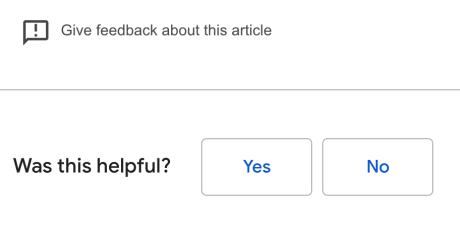Quick and Easy User Testing
You put time and care into making each web page, from content and features to design and media. But how is it performing with users?
You can look to site analytics to see how much time people are spending on your website. But how effective is your content? Are users getting lost or frustrated? Are they not finding the things you want them to find?
Numbers only tell part of the story. One of the quickest and easiest ways to learn more is through user testing. And it doesn’t have to cost a lot! In fact, anyone can get started doing testing today.
The first opportunity to test your websites is before you make changes. You may know you want a new design or new content, but let’s make sure you understand what is working now.
Start with surveys

Begin by asking your users what they think. It doesn’t have to take much time.
Come up with a handful of questions at most. You could ask them “why are they visiting” or how they would rate various tools for your site, such as “how did you find the donation process.”
Creating a survey doesn’t have to be time consuming or costly. If you use a CMS such as Drupal or WordPress, you have access to tools such as the Webform module or the Gravity Forms plugin for creating forms and gathering user input. There are many third party options as well, such as Survey Monkey or Mailchimp, though these may cost a small amount of money to use.
If you already have a mailing list of users, such as with a newsletter, you could start by sending them a link to your survey. Another option is to ask visitors as they come to your site, via a banner or callout block added to the page. Add a link to your survey and invite them to share their thoughts.
On-page surveys are also a great way to gauge the performance of specific pages or sections of your website. You’ve probably seen the most basic form of these when browsing a help page on a site like Google. It’s the simple little checkbox form that asks “Was this (page) helpful?”

Having a feedback mechanism like this is like a simple survey. Plus you could add a field for additional comments if you wanted to start gathering more specific details from users (“tell us how this could be improved”?).
If you’re going to redesign your website, there are numerous opportunities for testing and engaging with your users. Here are just a few:
Card Sorting

If you are reorganizing your site navigation and sitemap, try to get your users input. They will always surprise you with their choices, and often upend your assumptions.
Card sorting is a popular starting point. For this exercise, present your test subjects with a wide variety of subject matter from your website, each one written on an individual card (real or virtual). Then ask them how they would organize or group the cards together. The results will reveal how users think about categories and content groupings, and begin to suggest a site navigation.
Traditionally this exercise was done with actual index cards spread on a table for users to work with. But this can be done virtually as well. A free or low-cost method is using a tool like FigJam or Miro with users. Give them access to your board and cards, and they will be able to rearrange and group cards over the Web.
Tree Testing

An alternative to card sorting is another exercise called tree testing. We’re again testing the site navigation, but this time we’re starting from a more opinionated point of view. You will already have a site navigation put together, but want to test how accurate and effective it is.
You don’t need a fully designed page or mockup for this test. Just a simple “tree” navigation, with your top-level navigation, and optionally the “sub-navigation” of links that will appear underneath each primary option (e.g- dropdown navigation).
This test can be a bit more involved, time-wise, as you’ll want to craft a series of questions and scenarios for your users to start with before moving through your test. Ask them how they’d find something, using the navigation you present, and then take observations of where they go. There’s no actual “doing” beyond this - you just want to see what choices they would make (and if they’re the ones you expected and wanted).
This level of testing will either confirm the decisions you’ve made, or completely upend them! Either way you will have good data to use in making your sitemap better. Ten questions are plenty, by the way, you don’t need more than that for a single test.
Tree testing can be conducted in a variety of ways, from in-person tests with printouts to virtual tests over the Web. If you have access to a wide variety of users in-person, that may be best, but I’ve found this is a test that is easily done online (and takes a lot less time).
For online testing, a cheap (but more time consuming) method would be to share your screen with a user, ask them questions, and make observations on how they interact with a plain site navigation (it could be a simple spreadsheet).
A more efficient way to run your test online is using an online service. With these services, you can enter your questions ahead of time, and set up your site navigation tree, and then any number of users can come visit your test and results are recorded automatically. Costs vary by service provider. We've had success using Treejack testing by Optimal Workshop.
Click Testing and Paper Prototypes

If you are going through a design stage, you likely are starting with a series of static mockups for your site. While design decisions are best made between a small group of people, you can always test the results before committing design to code.
Click testing is a simple process of showing a page mockup to a handful of users and asking them how they’d complete a task. They won’t be able to actually “go” anywhere, as these are just static mockups, but you can get a sense of how they think they would proceed. Do they find the information you want them to see on the page? Do they understand the layout? If not, then now is a good time to make some design adjustments to help them out.
Like the sitemap testing, this can be conducted both in-person and virtually. For in-person testing, you should plan on bringing printouts of your design to your test, and observe where users point their fingers on the page (in response to your questions).
There are more sophisticated options through services like Optimal Workshop that will record actual clicks on the mockup, and allow you to run unmoderated tests through any number of users. But we’ve found success with smaller groups as well, where a member of our team will conduct the test via Zoom with users. We share our screen of mockups and simply make observations on where users point their cursor.

This is perhaps the most involved and time consuming portion of testing, but that doesn't mean you can’t do it yourself. For this test, a moderator (you?) is leading one-on-one testing sessions with actual users, asking them questions and observing how they proceed.
This is typically done with live web pages. It might be a stage you conduct as you near site launch (beta testing), or something you conduct after the initial launch of your site.
In either case, the parameters of this level of testing are fairly simple.
- Decide what it is that you are testing. It can’t be everything!
- Write up a list of scenarios for your users to do (e.g - you are a patient looking to make an appointment)
- Recruit 5-8 users to participate in the test. (offer them some kind of small gift as an incentive)
- Schedule times for testing. You can use a tool like Calendly for free.
- Conduct (up to) 30 minute interviews with each test participant, and write down observations of how they do.
With moderated testing, you’ll want to familiarize yourself with best practices in conducting interviews, and spend time afterwards analyzing the results.
There are beautiful, amazing labs dedicated to user testing, but you don’t need them to get started. Just use the space you have available. Like all of our testing, these can be done in-person or virtually.
I’ve found virtual testing to be the most cost effective approach. Using a tool like Zoom makes it easier to find and schedule test subjects, and by recording the tests, you can go back afterwards to take notes and make your observations.
Even if you never change your site over time, change is still happening with your users
Much of the testing we’ve discussed so far revolves around a redesign process. But testing isn’t just for those rare moments when you redesign your website. It can and should be an ongoing process!
Even if you never change your site over time, change is still happening with your users. New technologies, new patterns, and new services are continually rolling out, and user expectations on how the web should work is also changing. What worked last year may no longer be effective.
Surveys and feedback forms can be used at any time (or all the time) to keep gaining new insights on how your website is performing. Looking at your site analytics over time, how are your pages performing? Is traffic down or abandonment rates up? Perhaps users just aren’t finding what they need. How would a little tweak to your navigation or design help? Wouldn’t you rather find out through a small group of testers before changing it for everyone?
Plan on regular testing with your users to keep your site fresh and effective. As we’ve shown above, testing doesn’t have to be overly complex or expensive. Just start trying some things out and see how you do.
If you find it all overwhelming or don’t have time to do it yourself, talk to an agency like Electric Citizen. We offer testing during full redesigns as well as for our ongoing support clients.
Not testing at all will be more costly to your organization over time than any single testing exercise you could do today.




Join the Discussion +